Weapon Wednesday: Preparing for ROM Revealed
Published
Categories
Author
Blog Post
As part of the ROM's celebration of being open for 100 years, we will be having a massive behind-the-scenes open-house called ROM Revealed on the 3rd and 4th of May. Thousands of visitors will have the opportunity to see our storage rooms where we keep the objects not on display. There are a host of reasons why objects are not put on display. Some are fragments from excavations that are important to study for our research, for instance, providing the knowledge that makes the ROM an internationally known research centre in some disciplines. Sometimes we have more of a certain type of artefact than there is room for in a gallery, although the objects themselves are worth seeing. At other times they are not quite good enough for display, but are still worth keeping for research purposes, used to advance the knowledge seen in the gallery labels.
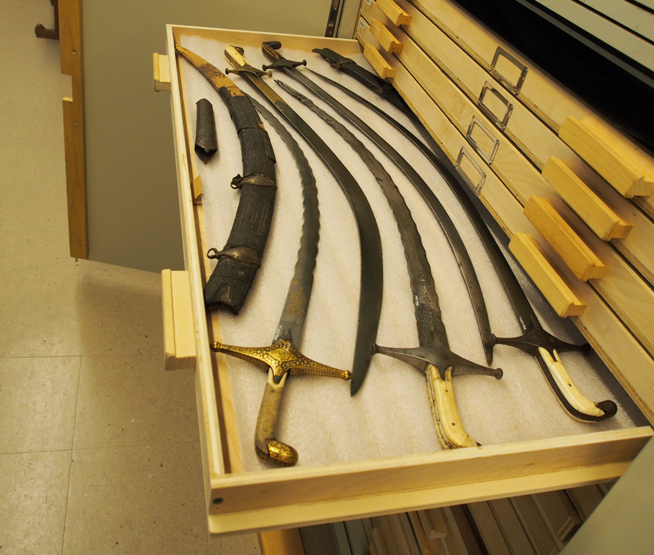
A drawer filled to overflowing with Persian swords, most of which were acquired in India by Lord Kitchener.
Arms and armour are typically in that second category. Many collectors in the past have acquired weapons and armour, and have donated or bequethed their collection to the ROM. For instance Lord Kitchener left the ROM a large collection of weaponry comprising over 700 objects, acquired during his campaign in the Sudan and while he was Commander-in-Chief of the army of India from 1902-1911. Although arms and armour are popular with collectors, if we put out all of our exhibitable objects of this nature, certain regions, such as South Asia and Japan, would seem overwhelmingly military in nature, entirely due to the interests of Western collectors. So the ROM's galleries exhibit an appropriate cross-section of the crafts and arts of each region and period.
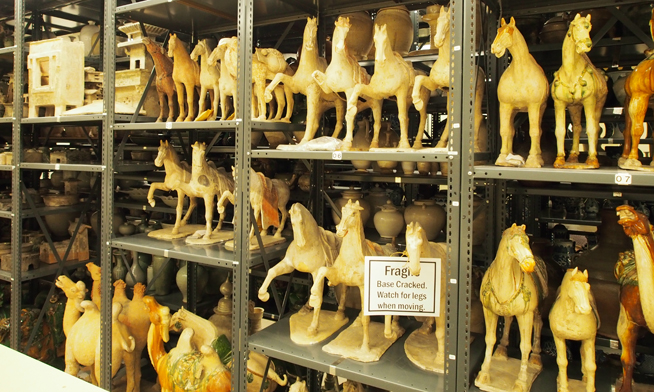
T'ang period ceramics on sub-standard shelving in our East Asian storage, interesting to see, but dangerous to be near.
The Curatorial Centre was part of the 1978-1984 expansion of the ROM, and this is where most of our collections are stored. The 6th floor of the Curatorial Centre is where I work, with collections from the three Curatorial sections dealing with Western Asia & the Islamic World, Ancient Egypt & Nubia, and East & South Asia. While the ROM focussed on expanding the galleries, at times what was originally temporary storage solutions from the 1978-1984 expansion have never been replaced, some are below current standards, and all of them are overcrowded. One of the problematic storage methods is open metal shelving. For instance we have Chinese ceramics, from Tang dynasty horses to Ming Blue and White, each worth tens of thousands of dollars, sitting on these open shelves. This would have made it impossible for the public to be near them during ROM Revealed: one slip and someone will fall into an object with a value in 6 digits. So with the help of our volunteers and other staff, especially Frankie Nancoo of Facilities, collection managers Bill Pratt, Gwen Adams, and I created a plan to change the arrangement of storage on the 6th floor, at first to make it accessible to the public, but also taking advantage of the move to improve storage, and also make it visually more interesting and accessible where possible.
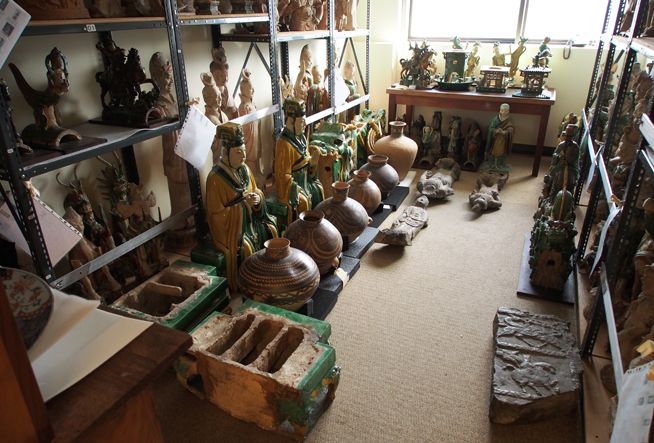
Many objects had to be moved into a "swing-space" so that storage could be moved, then have the objects moved again to their final location.
So this took a lot of planning. As an archaeologist I am familiar with making plans of excavated buildings, so I created a plan of the 6th floor, and we used that to strategize what could be moved where. Without compromising access, we compacted some storage, such as double-stacking some wooden cabinets. This enabled us to open up "focus areas" built around work-height storage, which gives us space and work-surfaces to manage and study objects, but also to provide areas for people to congregate for behind-the-scenes tours.
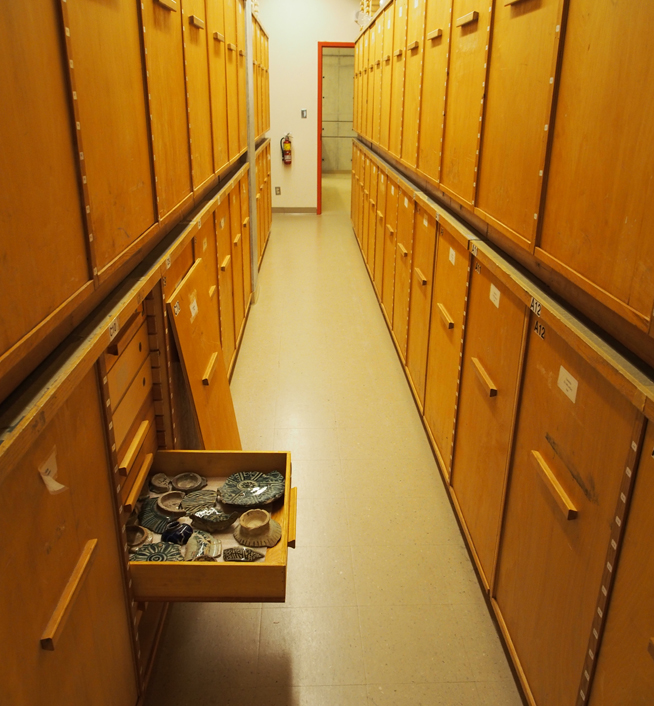
Some storage cabinets were double-stacked to take up less room, especially if they were not visually uninteresting! These old plywood cabinets were designed for storing archaeological materials, such as these 14th century AD shards from 0ld Cairo in Egypt. The removable doors actually facilitate access. We are in no hurry to replace these cabinets.

Compacting storage elsewhere enabled us to open up "focus areas," giving space and work-surfaces to manage and study objects, but also to provide areas for people to congregate for behind the scenes tours. This particular space is especially ample as it is hoped we will be able to replace the open shelving with more state-of-the-art cabinets that will be deeper but not as tall.
With all the activity getting ready for ROM Revealed we took the opportunity to improve storage where possible, for instance the Japanese armour is made of lacquered steel and fabric. Lacquer and fabric are sensitive to light, and so the armour had tissue-paper over it to stop the light; while the helmets were put in boxes closed with velcro that required rattling the object every time you wanted to look at it. Even though the armour is still on the open shelving, I have boxed in the open shelves with coroplast, an inert material, including removable "doors" kept on by magnets, which can be lifted off with no impact on the object. This is just a temporary solution and we should get closed steel cabinets for it, but we hope to get funding to re-house the Japanese armour and other parts of the collection.
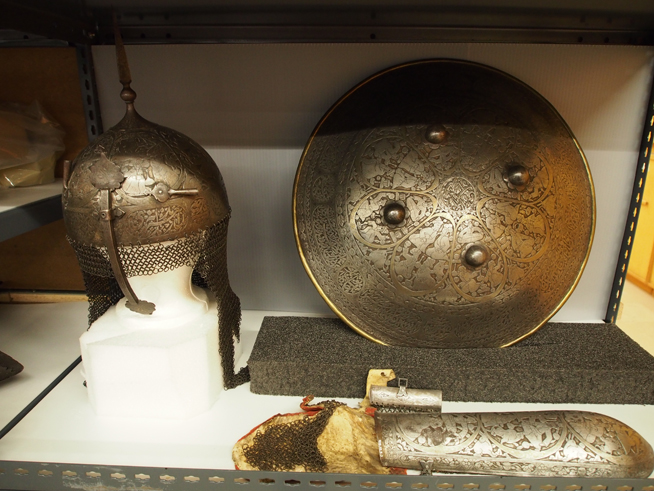
The "focus areas" are surrounded by storage that contained the more visually interesting objects, such as this set of Persian armour. Previously these would have been divided up and stored separately just to save room (helmets with helmets, etc.), but this makes the objects not only more interesting for the public, but is actually a preferable way to store the objects that belong together in one place.
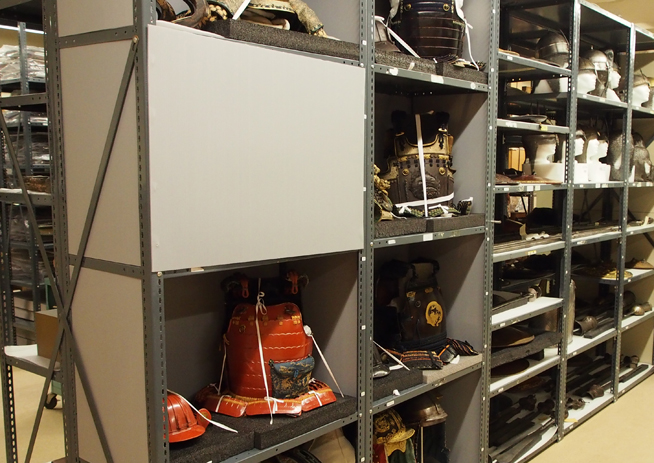
On this side of a "focus area" is South Asian arms & armour, and Japanese armour. Note the boxed-in light-sensitive Japanese armour, with one "door" put on for the photo which is kept on with magnets inserted into the corrugated coroplast panel.
So do come to our massive open-house, ROM Revealed, on May 3rd and 4th and see all the work we have done! We are hoping to replace the storage with more up-to-date storage eventually, perhaps focussing on one area at a time, for instance it would cost about $10,000 to re-house the Japanese armour properly.
Further reading


